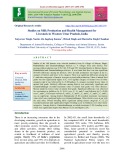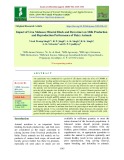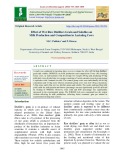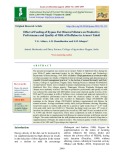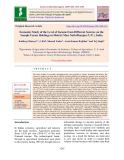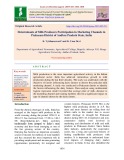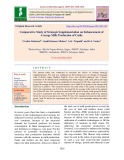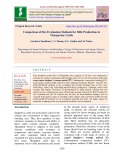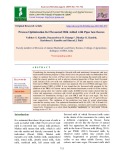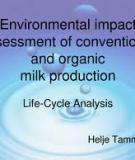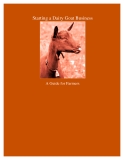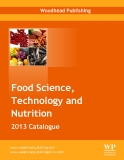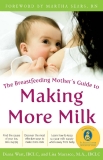
Average milk production
-
Consumption of milk and milk products is expected to differ for different occupational groups due to differences in the habits and social customs. Average monthly per capita expenditure (MPCE) of Uttar Pradesh is about rupees 899 and rupees 1574 out of which per capita expenditure on food in rural and urban areas of Uttar Pradesh is about rupees 521 and rupees 728, respectively; and percentage share of food in consumer expenditure is about 57.9 percent and 46.3 percent, respectively NSSO, GOI, 2009-10.
 9p
9p  nguaconbaynhay8
nguaconbaynhay8
 13-10-2020
13-10-2020
 15
15
 1
1
 Download
Download
-
The livestock population is expected to grow at the rate of 0.55 per cent in the coming years and the population is likely to be around 1.70 billion by 2050. Though India is among the leading producers of milk, meat and eggs, productivity of our animals is 20-60 per cent lower than the global average due to improper nutrition. Half of the total losses in livestock productivity are contributed to the inadequacy in supply of feed and fodder (DARE/ICAR Annual Report (2012–13).
 6p
6p  cothumenhmong7
cothumenhmong7
 09-09-2020
09-09-2020
 14
14
 1
1
 Download
Download
-
An experiment was conducted for a period of 120 daysto study the effect of UMMB as supplementary feeding and deworming on the reproductive performance and milk yield of dairy animals. Twenty milking cows of 4 to 6 years age group were selected randomly with initial average milk production of 6.22 liter per day. Before the start of experiment all the animals were dewormed against internal and external parasites on first day and from next day all the animals were divided in two group viz T1 control (farmers practice) and T2 feeding UMMB 300 g per day.
 7p
7p  nguaconbaynhay7
nguaconbaynhay7
 15-08-2020
15-08-2020
 19
19
 2
2
 Download
Download
-
The present study was conducted during 2013-14 both in Northern and Southern districts of Karnataka i.e. Dharwad & Tumkur to observe the expenditure pattern of Sthree Shakthi Group members viz., on food, clothing and House Keeping. Three hundred Self Help Group members (120 & 180 SHG members from Dharwad and Tumkur districts respectively)were selected and interviewed using pretested interview schedule. It was noticed that on an average, Dharwad SSG members’ families spent Rs. 6,125/- to that of Rs.
 5p
5p  quenchua6
quenchua6
 15-06-2020
15-06-2020
 10
10
 1
1
 Download
Download
-
A study was conducted in lactating dairy cows to evaluate the effect of wet rice distillers’ grain and soluble (WRDGS) on milk production and composition. Forty (40) lactating Jersey cows, in mid-lactation with an average live weight 350 kg and producing 8-9 kg milk daily were divided into two groups consisting of twenty animals in each group having 4 replicates with 5 animals in each.
 6p
6p  trinhthamhodang1213
trinhthamhodang1213
 02-06-2020
02-06-2020
 15
15
 1
1
 Download
Download
-
The data on productive performance and quality of milk was collected by contacting with 200 buffalo owners and chemical quality in terms of fat, SNF and TS percentage in milk of buffaloes were evaluated and analysed statistically to see the productive performance and to know the chemical quality of milk. Average maximum weekly milk yield was recorded in Thanegaon village (59.28±0.69) and minimum in the Akapur village (58.87±0.84) buffaloes supplemented with Bypass fat mineral mixture.
 9p
9p  cothumenhmong4
cothumenhmong4
 23-03-2020
23-03-2020
 17
17
 3
3
 Download
Download
-
There is need of improved and innovative technology to raise production and productivity for enhancing efficiency of agriculture in NER. The Tribal Sub-Plan (TSP) is a strategy for Socio-economic development and livelihood security of tribal people of Meghalaya. The study was conducted to assess the socio-economic status of the respondents and to analyze the tangible and intangible benefits of the interventions in Rongram block of West Garo Hills distrct of Meghalaya. A total sample of 120 respondents was drawn from the different technological components.
 10p
10p  cothumenhmong3
cothumenhmong3
 22-02-2020
22-02-2020
 20
20
 1
1
 Download
Download
-
The main variables of economic development have been regarded as Income, Investment and Saving. The increase in capital stock along with its efficiency directly influences the productive capacity of the economy for increasing the total output or income. However, the growth in capital is in turn directly dependent on the part of additional output which is not immediately consumed but is saved and available for investment or increase in capital. The farmers of the study area were having two main source of income, i.e. Agricultural and nonagricultural sources.
 10p
10p  cothumenhmong3
cothumenhmong3
 22-02-2020
22-02-2020
 17
17
 0
0
 Download
Download
-
Milk production is the most important agricultural activity in the Indian agricultural sector. India has achieved tremendous growth in milk production during the last three decades. The study was undertaken with the objective of factors influencing dairy farmers to choose the particular milk marketing channel. A study was conducted in Prakasam district to identify the factors influencing the dairy farmers.
 5p
5p  nguathienthan2
nguathienthan2
 25-12-2019
25-12-2019
 31
31
 0
0
 Download
Download
-
The present study was conducted to ascertain the effects of feeding Strategic supplementation. The trial was conducted on 40 lactating cows on villages of Jasinagar road of district Sagar, Madhya Pradesh. Cows were divided randomly into 4 dietary treatments of 10 animals each considering their body weight, milk yield, parity and stage of lactation. The experiment was conducted for the period of 180 days. In group I (control group) the average milk yield of the animals was 4.420.28. In group II, the average milk yield was 4.23±0.73.
 6p
6p  nguathienthan2
nguathienthan2
 19-12-2019
19-12-2019
 11
11
 0
0
 Download
Download
-
The present investigation is an attempt to study in the title “Economic aspect of dairy farm-keeping in jaunpur district of Uttar Pradesh” specifically, it aims (i) to work out the economics of milk production in different size of dairy units. (ii) to work out the net income and as cost/liter of a dairy farms. (iii) to identify the various constraints in milk production and to suggest measures for promoting live stock development. The study is based on data collected from 16 progressive dairy units in semi-urban areas of Jaunpur district of Uttar Pradesh.
 5p
5p  quenchua2
quenchua2
 15-12-2019
15-12-2019
 12
12
 0
0
 Download
Download
-
First lactation records (91) of Tharparkar cows, progeny of 10 sires, were analyzed to estimate the variance components and breeding values of sires for first lactation milk yield using simple daughter’s average method ( ), Contemporary comparison method (CC), least-squares method (LSM) and best linear unbiased prediction (BLUP). Using , CC, LSM and BLUP methods of sire evaluation the average breeding value of sires were 1849.10 kg, 1836.17 kg, 1858.65kg and 1859.03 kg respectively.
 5p
5p  cothumenhmong1
cothumenhmong1
 11-12-2019
11-12-2019
 12
12
 0
0
 Download
Download
-
Considering the increasing demand to flavored milk and nutritional, therapeutic and post meal mouth freshener property of Piper betel leaves the present study was undertaken with object to optimize the levels of Piper betel leaves for developing flavoured milk and to study the sensory qualities as well as physico-chemical properties of Piper betel flavoured milk. Initially fresh cow milk was standardized to 2% fat and aqueous extract of piper betel leaves (PBLE) of different verities were prepared. The level of PBLE and sugar were optimized using CCRD of RSM.
 12p
12p  chauchaungayxua1
chauchaungayxua1
 04-12-2019
04-12-2019
 15
15
 1
1
 Download
Download
-
Although the livestock sector has a significant contribution to the national economy, production per animal is extremely low. The average lactation milk production of the indigenous cows ranges from 494–850 kg under optimum management (EARO 1999; Haile et al. 2009a). The trend is similar to beef production. It is indicated that crosses of Ethiopian Boran with Hereford, Aberdeen or Charolais had 20–30% higher body weight than the pure Ethiopian Boran (EARO 1999).
 515p
515p  conduongdinhmenh
conduongdinhmenh
 07-05-2013
07-05-2013
 41
41
 5
5
 Download
Download
-
Butler reported that the net returns from organic production in 1999 were more than twice those from conventional production on dairies of a similar size. However, compared to the state average, returns to organic production were less than for conventional production. The author noted that these returns are specific to conditions in 1999. Organic producers are paid a fixed price per hundredweight (cwt) for organic milk determined by organic creameries that does not vary monthly.
 170p
170p  conduongdinhmenh
conduongdinhmenh
 07-05-2013
07-05-2013
 50
50
 5
5
 Download
Download
-
Dalton et al. reported the average production costs and returns for 2004 from a sample of 30 organic dairy farms in Vermont and Maine. They reported a total cost for organic milk production of $22.58 per cwt, before a deduction for unpaid operator labor and management, which was not significantly different from milk revenues. Thus organic milk production did not generate any return to unpaid labor and management nor did it produce a positive return to farm assets or equity.
 30p
30p  conduongdinhmenh
conduongdinhmenh
 07-05-2013
07-05-2013
 61
61
 4
4
 Download
Download
-
There has been only modest improvement in the productivity of indigenous cows, cross- breds or buffaloes over the last two decades in India (Table 1). The average daily milk production data at 6.52 kg for crossbreds, 2.10 kg for indigenous cattle and 4.44 kg for buffaloes (NSSO, 2007) suggests that the productivity of these animals is far below their genetic potential.
 109p
109p  conduongdinhmenh
conduongdinhmenh
 07-05-2013
07-05-2013
 60
60
 9
9
 Download
Download
-
Overall welfare effects are slightly positive for the EU-27. Whereas total agricultural income would decline due to lower milk prices on average, the EU dairy industry would benefit as prices of dairy products are expected to decline less than raw milk prices (i.e. input costs decreasing more than revenues). Impacts on the FEOGA budget would arise mainly from additional export subsidies for butter and moderate losses of tariff revenues.
 64p
64p  conduongdinhmenh
conduongdinhmenh
 07-05-2013
07-05-2013
 69
69
 9
9
 Download
Download
-
Equivalent units of production for a period can be computed in different ways. In this chapter, we discuss the weighted-average method. In Appendix 4A, we discuss the FIFO method. The FIFO method of process costing is a method in which equivalent units and unit costs relate only to work done during the current period. In contrast, the weighted- average method blends together units and costs from the current period with units and costs from the prior period. In the...
 304p
304p  conduongdinhmenh
conduongdinhmenh
 07-05-2013
07-05-2013
 47
47
 12
12
 Download
Download
CHỦ ĐỀ BẠN MUỐN TÌM









